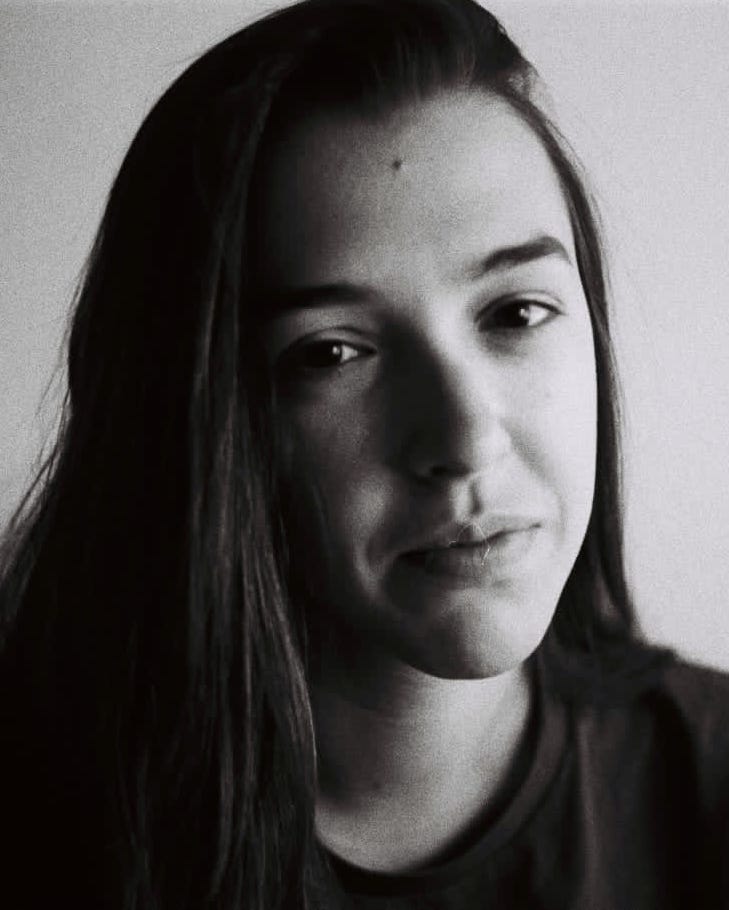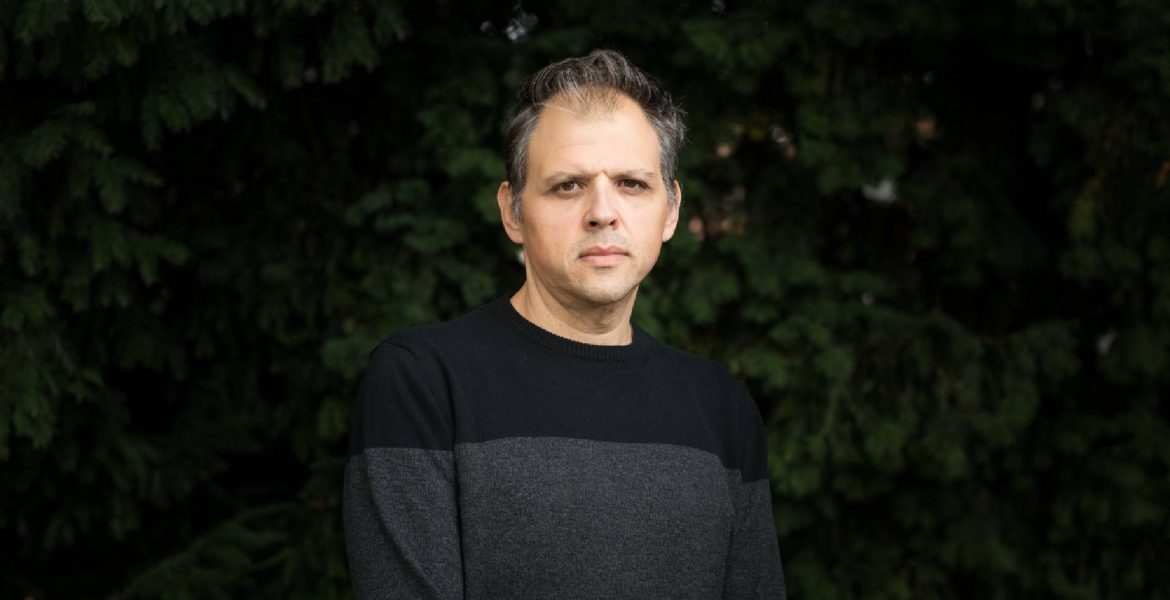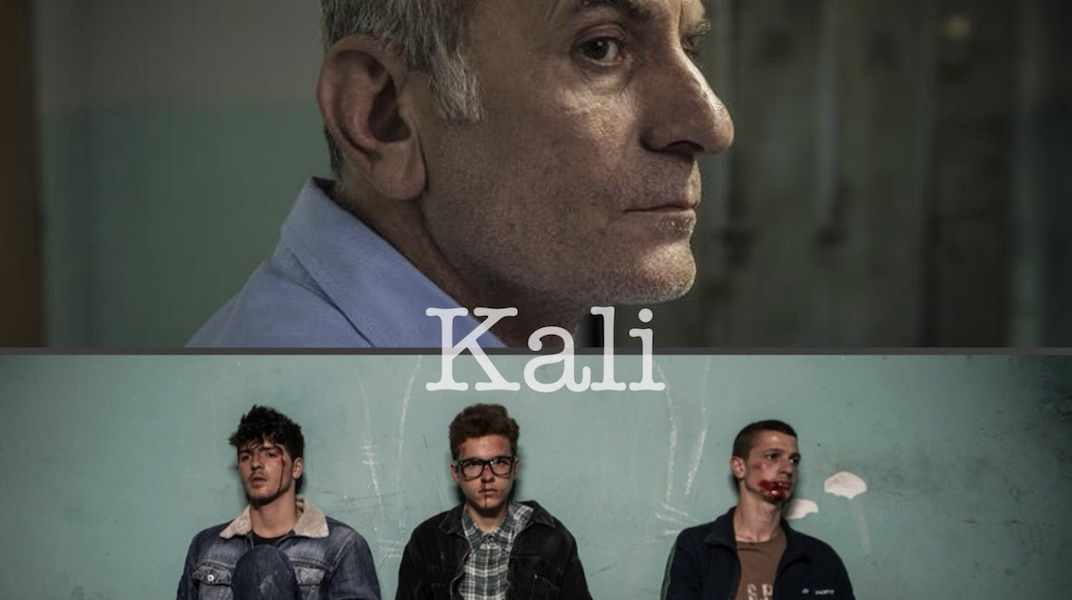Photo by: Ivan Buvinić
Vladimir Gojun is a film editor with an impressive work biography. His editing work includes both feature and documentary films and he has also tried himself in the role of director. He is also the editor of the only mockumentary (pseudo-documentary) film from former Yugoslavia titled “Houston, We Have a Problem”. He is the recipient of the prestigious Slovenian award “Vesna” for his work on “The Miner” and the previously mentioned “Houston, We Have a Problem”.
Alongside all the films you worked on, you also edited the film “Murina” by Antoneta Alamat Kusijanović, a film that achieved global success last year and even won the Camera D’or Award at the prestigious Cannes Film Festival. “Murina” is its author’s debut film and an intimist story about growing up. It is distinguished by a specific, tense and at times almost thriller-like atmosphere which is shaped by the film’s rhythm. What was it like, working on this film? How would you describe the collaboration with the director on her first feature film? What is it that makes this film stand out in your experience?
Antoneta and I go back a long time as we were both born and bred in Dubrovnik. Even though there is an age gap between us, we have continued our acquaintance and friendship both during our time at the Academy of Dramatic Arts in Zagreb and throughout our professional careers. I suppose it was predestined that we should collaborate at some point. Working on “Murina” was not all that different from my other projects as I happen to take the same approach to every film I work on. However, it is the directors’ projects and approaches that give peculiarity to a film. Antoneta is certainly a peculiar author, both personally and professionally. Regardless of the fact that this was her debut film, she showed a rare maturity in her approach to the topic she addressed, which to me, as her associate, is particularly inspiring and stimulating. Every film is a result of great dedication and sacrifice and “Murina” is one such film. For the first time in my career, I had an opportunity to see what the support of a famous director feels like. Martin Scorsese, one of the world’s greatest directors who inspired me to do what I do, was some sort of a mentor and support throughout the post-production phase. He was genuinely interested in all phases of editing, dedicating his time to help us and rooting for us from the background.
Apart from “Murina”, you edited a number of debut films such as “Men Don’t Cry” by Alen Drljević, “You Carry Me” by Ivona Juka as well as Nina Violić’s debut film which hasn’t had its premiere yet. What experiences do you have working with directors on their first feature film? What does working on debut films generally look like? What is the role of the editor in a situation when you are faced with a director who is directing a feature film for the very first time?
All my experiences with new directors have so far been mostly positive and inspiring as every one of them goes on to reveal a new universe; they let you in and put their trust in you. I am happy that they very often decide to work with me because, alongside that trust, they give me access to their ideas, thoughts, views and motivations, which is a real privilege for me. Moreover, they provide a new energy and new perspectives which may have been outside my horizon. It is, in fact, a very rewarding situation. Additionally, what I find most appealing and interesting – which, by the way, is their most represented feature – is that incorruptibility and imperfection of material reflecting their own naïveté, honesty, courage and conviction that can turn into an untamable beast during the process. When that happens, the editor will try and help the director express his/her vision.
Alen Drljević’s film “Men Don’t Cry” is based on real-life events from the lives of veterans from the 1990s wars. The film “The Miner” by Hana Slak is also based on a true story of a miner, Mehmedalija Alić, who discovered a mass grave from World War II. What was it like to be working on films based on true stories? As regards “Men Don’t Cry”, we are also talking about a peculiar documentary type of direction and shooting, with long scenes and actors’ improvisations. What was your editorial approach to such a project?
It is necessary that we should always have a sense of social responsibility, ethics and above all, empathy which affects the creative treatment of a certain topic, particularly in the case of events that are still fresh in our collective memory. Both those films you have mentioned discuss this region’s recent past and are therefore much more delicate for all – for both the people working on the film and the people the film speaks to. Moreover, I believe it is very important to grasp the creative nucleus that forms around a film. “Men Don’t Cry” is one of the positive examples in my career. In my opinion, this film was made by the best possible crew from the region, a responsible and courageous group of creative people united by a common goal – to try and break the prejudices and myths that have been poisoning and demoralizing this society for a long time. We were all quite prepared for that film. What I was able to recognize from very early on was Alen’s and Erol’s (author’s note: Erol Zubčević, director of photography) approach which, as it turned out, coincided with my idea and vision as to how this film should look like, so I tried to build on that vision. The documentary features visible in certain scenes, which is mostly due to a great coordination of interpretations of the entire cast and the directorial and cinematographic approach which is very reminiscent of the observational approach in documentary films, were a sensible starting point for me. Had it not been for the above-mentioned elements that fell into place, the film would have probably lost its authenticity and strength. It would have ended up being a cliché construct we have had the opportunity to see onscreen countless times.
You have worked as editor on both feature and documentary films. How does working on a feature film differ from working on a documentary structure? Which form is more appealing to you as editor and author?
As opposed to feature films, documentaries require a different “reading” of material which is more focused and detailed. Additionally, it requires much more time for editing, research and finding the essence. When it comes to focus and dedication, there is no difference. I still prefer the feature form because for me it appears to be some sort of personal escapism, but my ambition is to find a challenge in either form.
“Houston, We Have a Problem” is a unique film in regional cinematography. A mockumentary or pseudo-documentary film is quite a peculiar film form which is very rarely seen, or hardly ever in our corner of the world. What was it like working as editor on this film? What are your views on the film and the success it has made?
I would prefer to call it “docufiction”, but the term “pseudo-documentary” suits it just as well. I recently saw the film again and remembered all the post-production phases and work on the film. It was a unique experience which, regardless of a clear dramaturgical structure at the beginning and despite its combined documentary and feature form, required a lot of re-writing and modification of the original screenplay. Because of that, my approach was at some point the same as the classical approach to editing a documentary film in which, through the editing process, you actually “write” the screenplay of the film. Reading the screenplay, I was able to anticipate certain dramaturgical traps that later proved to be much more challenging than we had initially thought they would be. In any case, for me it was a new experience that resulted in a film which to this day leaves no one indifferent; it is thought-provoking and it encourages us to re-examine social mechanisms.
You also worked on “Buick Riviera”, a film based on Miljenko Jergović’s novel of the same name. The transposition of structures from different media onto film is an extremely demanding task. In the case of literature, it is due to the fact that written words have their own rhythm, which is a reflection of the author’s style of writing. How did you approach this film? What are your views on transferring a story from one medium to another?
This film is my baptism by fire, my initiation into the world of professionals, my first independent editorial work and as such it has a special place in my work biography. At the time, I thought that the novel’s adaptation into the screenplay had been cleverly and innovatively done. The director’s discourse provided an additional dimension – the manner in which Goran Rušinović intended to tell the story was completely opposite of how the novel was written. It was almost magical. The film gradually opened up to the viewer, creating a meditative atmosphere underneath which tingled a constant discomfort which was flirting with the oneiric. In spite of it all, I had a clear dramaturgical vision from the beginning, but we allowed ourselves to experiment and at times delve into abstraction. The cinematographic work of Igor Martinović made a substantial contribution as he managed to create an additional space, a universe that could be shaped and researched through editing.
It is a common misconception that film adaptations of literary works are for the most part inferior to the original. In that case, however, I believe that every adaptation should be viewed as an independent work that does not necessarily require comparison. I have always felt that it is an unjust burden that every film based on a literary work has to bear. Even though I very often catch myself comparing the two and making judgments based on that comparison.
Film editing is said to be the screenplay’s final stage. In any case, it is a process which includes creating a separate dimension of the film’s world, i.e. the film’s own space and time. You have so far worked on a number of stylistically different films and with many different authors. What does the authorship of the editor mean to you? What is your view on the position of an editor in a film’s organism?
To be honest, I have always tried not to mystify our work even though it is sometimes necessary in order that we could emphasize the importance of editors in film creation. Our role is often neglected and insufficiently emphasized. In short, film editing is what makes a film what it really is and that is a fact. Our authorship is omnipresent, with every mouse-click and it is not only reduced to its mechanic function. Everything that we as editors cognitively and emotionally process is the product of what the spectator sees while sitting in a cinema, on their couch or just scrolling on their mobile phones. Moreover, the editor’s role is not just creative. I dare say, it is – conditionally speaking – altruistic as well. Especially when it comes to our relationship with the director. The bond you create during the process is priceless, albeit uncomfortable at times. Personally, I have always felt that it is necessary that a film editor should be a lot more than a mere implementer, a creative thinker who helps the director transmit his/her vision to a wider audience. There is a certain unimposed but implanted responsibility that we by default assume once we have taken over the material and accepted the director as our associate. There is a lot of diplomacy, psychology, psychotherapy, understanding and acceptance there. I sometimes wonder why we, as film editors, do not have many more qualifications than those we earn from our work, talent or our university degrees. If I were to play with metaphors or try to be overly poetic, I would say that my job is to be as faithful a companion to the director as I can be, a Sancho Panza to my Don Quixotes (laughs).
You tried yourself in the role of director in documentaries “Cycles” and “Times of Great Depression”. Those are two very different films – the first is about fighting a disease and the latter is a musical documentary. What was your motivation behind the decision to take up the direction of these films? How did your editorial legacy and experience affect your directorial approach? Are there any plans to try and direct a feature film?
Both my attempts to take up direction were but moments of inspiration and a result of the necessity to show how, in the first case, a young person deals with a serious illness and how that affects me as someone who is very close to that person, whilst in the second case, my intention was to reveal one of the most hidden treasures of Croatian independent music to the wider public. Both these films were about people who are close to me, my friends, individuals who found themselves in the midst of a difficult struggle for their existence, each in their own particular way, but both equally memorable and important. Had that not been the case, I doubt I would have ventured into such a task. My editorial experience was useful to the extent that I could observe the situations in which the characters find themselves with more focus and pinpoint the story that could attract the viewers’ attention and simultaneously convey the essence. In the case of “Cycles”, I was less prepared as the filming started unexpectedly, in medias res, just improvising and organizing everything in a few days, practically by surprise. I dispersively followed the situations and subsequently assembled the mosaic, the narrative and dramaturgy during the editing process. With “Times of Great Depression” it was the other way round. We had time to prepare, to organize everything and we had a more focused approach and an established structure that only gained shape and strength during the editing process. Of course, my editorial experience helped me to view my own material in a more objective way and, what may seem unusual, to be more ruthless and critical and less protective towards myself as the author. To be more honest. I do not know how I would cope with feature films. Maybe someday I will pluck up the courage and try that form as well.
Women have now started appearing as directors even in this corner of the world, but they are still an exception to the general rule. As an editor, you have, however, worked with a number of women directors (Antoneta Alamat Kusijanović, Hana Slak, Ivona Juka) on films that have achieved significant success. What are your impressions regarding female authorship and appearance of women in that position? What experiences do you have working on their films?
The best thing that could happen to our film industries, which daily proves to be a true and irrefutable fact, is a greater concentration of women and generally their appearance as film creators. Theirs is a perspective that has long been missing or was else unjustly ignored in this part of the world, especially in films. I had the good fortune and privilege to work with many women directors and I am currently working with quite a few of them. They are all new, authentic voices who, up until fairly recently, had no place on our cinematographic map. By saying that I mean the entire region. I am not at all surprised that now that we as a society and a community have finally allowed them to have their well-deserved space, our cinematography has achieved its greatest success globally and it is thanks to them that our states are now recognized and respected in festival circles and among the wider audience.
Despite the pandemic which seems to have blocked the cinemas and the entire film industry, films were still being made in the region in the past two years. You have worked on films by directors from Croatia, Slovenia, Bosnia and Herzegovina – from the entire ex-Yugoslav region, so to speak. What are your views on the regional cinematography? Are we talking about a culturally related area? To what extent do our respective cinematographies correspond with one another?
Bearing in mind all the recent achievements our regional, high-quality films such as “Quo Vadis, Aida?”, “Murina”, “Oasis”, “Honeyland”, “The Load”, “Tereza 37”, “The Staffroom”, “The Beehive” and others have had at world festivals, I believe the regional film production as it has been in recent years, can be compared to the world’s leading cinematographies and it seems that it is making a grand comeback globally. As regards the cultural connections and relations between us, I find them to be inextricable, impossible to disregard and ignore, no matter how hard some people might try to do so. I believe the specificity of the language spoken and understood by more than 20 million people is only an advantage and a rare opportunity for a film to be recognized commercially and not just by the name of its author, which recently started happening despite the pandemic. Our film industries have always corresponded and will always correspond with one another and the proof of that is the creative, cultural exchange and collaboration constantly taking place in this part of the world. Croatian film workers, as well as Serbian or Bosnian, Slovenian and Macedonian and Kosovan even, successfully collaborate on various mutual projects, they are in demand and there is a healthy competition, mutual respect and artistic recognition. As far as I am concerned, that is the most convincing proof that things are changing for the better and that art, or more precisely, the art of film, is one of the countless things that bind us together and which we can without any hesitation claim to be the force that unites us.
We are currently witnessing a television “boom”, which is largely due to the pandemic. Thanks to the quarantine, various streaming platforms have begun to flourish, whilst cinemas seem to be on life support. As of late, it has frequently been the case that films are released directly on streaming platforms or simultaneously with their distribution in cinemas. How do you perceive the current position of the film industry? Will cinemas overcome this situation?
I sincerely hope so. Regardless of the current situation, I want to believe that we will return to cinemas as soon as possible. I have lately been witnessing situations that, apart from getting my hopes up that such a thing might be possible, have proven that a regional film could bring the audience back to cinemas. I recently attended a premiere of a Serbian film in Zagreb for which 12 cinemas had been sold out. I do not remember ever experiencing such a thing in my life, let alone with a film from this region. It was an incredible experience, being in the situation we all find ourselves in. The audience was mostly made up of young people, generations apart from my own. This instills hope that, in spite of this situation and modern technology, the audience still craves that collective experience and has the awareness that we can experience and share an emotion with hundreds of other people at the same time.
However, streaming platforms are not necessarily a bad thing. We all use them and they in turn try to provide high-quality and as versatile a content as they possibly can. TV series cannot be shown in cinemas anyway and as of late, they seem to be increasing in quality and becoming a more interesting form now superior to film.
It has been announced that you are to edit films directed by Nina Violić and Kosta Đorđević. What can you tell us about these and some other projects you have lined up for the future? What are your ambitions regarding your editing work?
Nina’s film has long been finished and we are awaiting its premiere. I am very happy and pleased that in spite of the scarce funds and such meager conditions, we were able to produce a film which is original, authentic and directorially mature. A very small crew worked on this film, but everyone gave their very best, investing enormous efforts and knowledge, which resulted in a very mature debut film. I am very proud to have been a part of this team. Kosta Đorđević has an incredible creative force and personality. “Žal” (Eng. “Sweet Sorrow”) is an ambitious and wonderful film, the kind of film I have not had the opportunity to work on before and I think that Kosta is an authentic Serbian director. The entire film crew was flawless – from the director of photography Bojana Andrić, to the producer Miloš Ivanović and the entire pleiad of finest young Serbian actors – Pavle Čemerikić, Denis Murić, Alisa Radaković, Pavle Mensur and the legendary Branka Katić. I am very happy with the results we have made so far and I believe that this film could be very successful. As regards my current and future projects, I am once again working with Jasmila Žbanić on her new documentary project and I am finishing my work on two other documentary films. Additionally, I have just started working on a short film. In the last few months I have been very busy working at the Academy of Dramatic Arts in Zagreb, so I am trying to balance between the two fields I work in. Film editing is my vocation and my primary interest and I think that it will stay that way. All the other activities I have taken up are but hobbies. (laughs)

Katarina Koljević was born in 1993 in Belgrade where in 2017 she graduated from the Faculty of Dramatic Arts, Department of Film and TV Directing. During her studies, her student short films were screened at a dozen film festivals. Her graduate film Life Lasts Three Days was supported by the Film Centre Serbia and SEE Cinema fund in 2016. It premiered in the students’ selection of the 2017 Sarajevo Film Festival. The film received the Youth Jury Award and Special Jury Mention at Bašta Fest. At her master’s studies in film directing at the Faculty of Dramatic Arts in Belgrade, she made the short film Family Vacation, which premiered at the Sarajevo Film Festival. She directed and wrote several radio-plays for Radio Beograd in 2018 and 2019. She works as a film critic and essayist for a web-based publication Filmoskopija which is a part of Serbian Film Centre. She works as an assistant director and casting director on TV shows and films.


